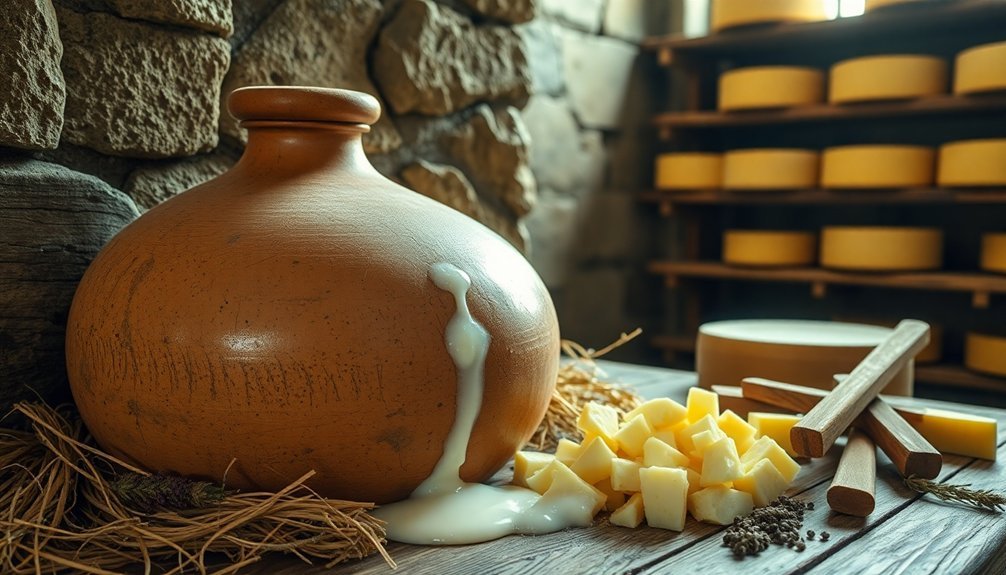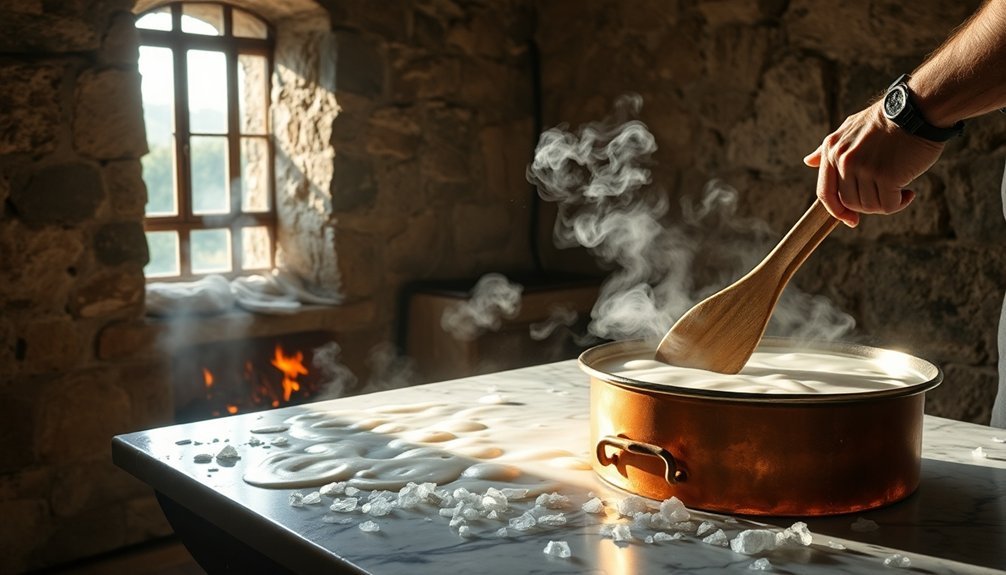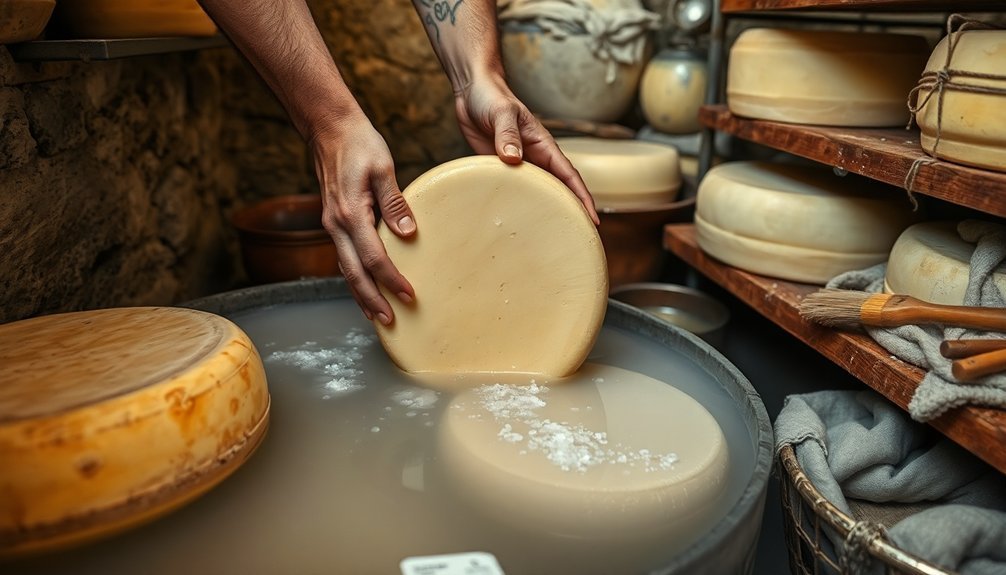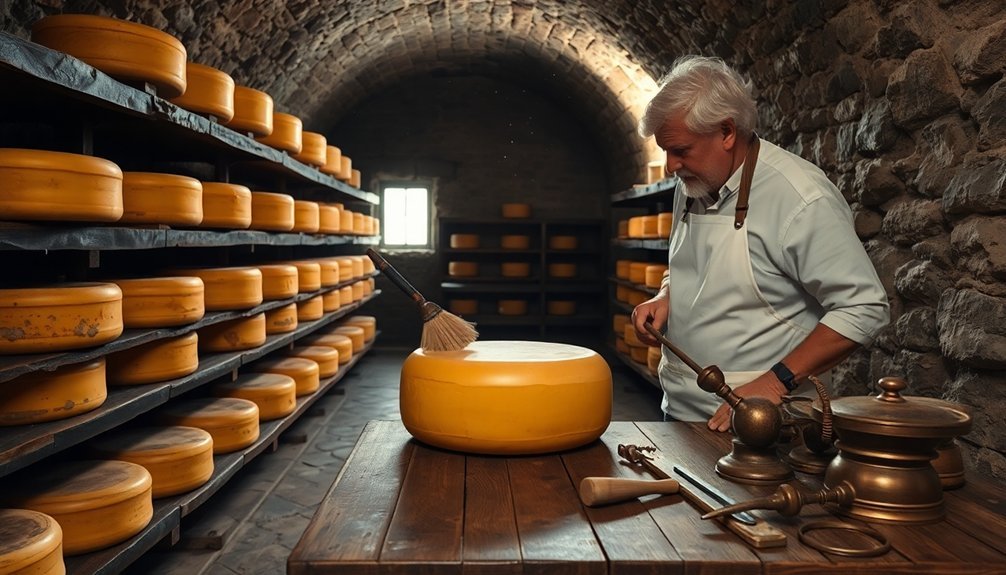Europe's most influential cheese-making methods span over nine millennia, starting with ancient stomach vessel fermentation where natural rennet sparked the first curds. You'll find Bronze Age innovations in mold pressing using perforated ceramic vessels, followed by the Romans' hot water curd technique for achieving ideal texture. Monastic traditions perfected aging in cool caves, while brine-washing methods created distinctive rinds. The Renaissance brought bacterial culture breakthroughs for consistent flavors, and natural rennet curdling refined the entire process. These seven methods laid the foundation for today's artisanal cheeses, with each technique holding centuries of culinary wisdom to explore.
Ancient Stomach Vessel Fermentation

In ancient times, cheesemaking began with a fortuitous discovery: milk stored in animal stomachs would curdle and ferment into a new, preserved food. When you examine this ancient method, you'll find that the stomach's natural enzymes, particularly rennet from young ruminants, played a significant role in transforming liquid milk into solid curds and liquid whey.
The process you'd observe relied on three key components within the stomach lining: rennet, beneficial bacteria, and lactic acid. You'd see how the enzyme chymosin in rennet would convert κ-casein to para-κ-caseinate, while naturally present bacteria broke down lactose into lactic acid. This acidification wasn't just significant for coagulation; it also protected the developing cheese from harmful microorganisms. Early cheesemakers found that black snails and bog violet could serve as alternative coagulants when rennet was scarce.
If you'd visited the Dalmatian Coast around 7,200 years ago, you'd have found early evidence of this fermentation method. What's fascinating is that you wouldn't see cheesemakers deliberately adding cultures; instead, they'd maintain their bacterial cultures through regular cheesemaking practices.
These early techniques laid the foundation for today's diverse cheese varieties, as different bacterial strains produced unique flavors and textures.
Bronze Age Mold Pressing
Archaeological evidence from Bronze Age settlements reveals a fascinating shift in cheese-making technology through the development of specialized pressing techniques. While you won't find sophisticated molds like those used today, Bronze Age cheese makers developed effective methods using basic tools and materials available to them.
You'll see evidence of this in the ceramic vessels with distinctive holes discovered across Europe, particularly in Kujawy, Poland, and along the Dalmatian coast. These vessels served as primitive strainers, where you'd place the curds to drain excess whey and form solid cheese. Proteins found in Taklamakan Desert mummies confirm the widespread use of these early cheese-making methods.
The process was straightforward: you'd curdle milk using natural bacteria or fruit acids, then press the resulting curds using simple weights or manual pressure.
Though you wouldn't find standardized molds during this period, the pressing techniques were quite effective. You'd typically use wicker strainers or perforated ceramic containers to shape your cheese, allowing it to drain and solidify naturally.
The end result would be a firm, salty cheese that's perfect for preservation in varied climates. This method was particularly essential in warmer regions, where you'd need harder, more preserved cheese varieties to prevent spoilage.
Roman Hot Water Curd Method

You'll find that Roman cheesemakers used hot water to break down milk curds, creating a more cohesive texture before pressing into traditional clay molds.
The process required careful temperature control as you pour the hot water over the cut curds, allowing them to heat evenly and settle into a firmer mass. This traditional technique dates back over 2000 years when Romano cheese first emerged near Rome.
Once pressed, you'd preserve the cheese by submerging it in salt brine or seawater, a method that both flavored and protected the final product.
Hot Water Breaking Process
Dating back to ancient Rome, the Hot Water Breaking Process stands as one of the oldest documented cheese-making techniques still used today.
You'll begin by heating non-homogenized milk to 176°F (80°C) for 20 minutes, breaking up any fat globs with a spoon to guarantee even consistency.
Once your milk reaches the proper temperature, you'll need to prepare a vinegar solution diluted in warm water. Add this mixture to your heated milk and let it sit for about 30 minutes. During this time, you'll notice signs of coagulation, including a wrinkly surface and semi-clear whey separation.
Next, you'll cut the curds into one-inch cubes using long knives in crisscrossing patterns. Gently stir the curds for 15 minutes to help separate them from the whey. You'll know they're ready when they become slightly stretchy and begin to mat together.
Finally, drain the curds in a cheesecloth bag, adding salt and any desired spices while kneading. Shape the cheese by hand or place it in boilable bags, then cool it in 40°F (4.4°C) water for an hour to set its final form.
Pressing Into Clay Molds
While the Hot Water Breaking Process gives us modern methods, the Roman Hot Water Curd technique offers a distinct approach through clay mold pressing.
You'll need to warm your milk to 32°C/90°F before adding culture and lipase, allowing it to ripen for an hour while maintaining temperature. Once you've achieved slight congealing, you'll add rennet and wait for proper coagulation.
The distinctive Roman process requires careful attention to temperature control as you heat the curds to 45-48°C/113-118°F. You'll notice the curds reducing to rice-sized particles as you stir consistently during the 40-50 minute heating period.
- Transfer your curds into traditional clay molds while they're still warm (85-95°F)
- Apply initial pressure of 3.5kg/8lbs using stone weights
- Gradually increase pressure to 7kg/15lbs over several hours
- Turn the cheese every 30-60 minutes for even consolidation
During pressing, you'll want to maintain warm temperatures to promote proper acid development. The clay molds, unlike modern materials, help regulate moisture and temperature naturally.
Let your cheese rest overnight at room temperature once pressing is complete, allowing for final consolidation.
Salt Brine Preservation Methods
Salt brine preservation stands out as a cornerstone of Roman cheese-making, carrying forward a tradition that's both practical and flavor-enhancing. You'll find that Romans often used seawater's natural salinity, creating a preservation method that's been refined over centuries.
To create an effective brine, you'll need to heat water to about 77°F and add salt until it no longer dissolves, typically reaching an 18% concentration. You can test the saturation by floating a raw egg – if it floats, your brine is ready.
Don't forget to add calcium chloride and vinegar to maintain proper pH levels and prevent calcium leaching from your cheese.
When you're brining your cheese, you'll need to guarantee even distribution by flipping it halfway through the process. If your cheese floats, you'll want to salt the exposed surface to create its own brine.
As you add fresh cheese to an existing brine solution, remember to replenish the salt to maintain its strength.
You'll notice multiple benefits from this preservation method: enhanced flavor development, effective mold inhibition, proper rind formation, and considerably extended shelf life.
This Roman technique continues to influence modern artisanal cheese-making.
Monastic Aging and Storage
Deep within medieval monasteries, monks pioneered some of today's most celebrated cheese-aging techniques. You'll find their influence in iconic cheeses like Brie, Camembert, and Munster, which owe their distinct characteristics to monastic ingenuity.
These religious communities mastered the art of creating specific aging environments, particularly in natural caves, where temperature, humidity, and mold activity could be carefully controlled.
- You'll discover that monasteries typically aged their cheeses in cool, damp caves, like the famous Caves at Cambalou where Roquefort has been aged since the 11th century.
- You'll notice that small-batch production, often using milk from just one or two cows daily, allowed for meticulous attention to quality.
- You'll find that monastery-developed aging techniques spread through regional cross-pollination, creating new cheese varieties.
- You'll see that monastic rules guaranteed these techniques were preserved unchanged across generations.
The monasteries' commitment to local production and distribution meant cheeses didn't travel far, maintaining their authenticity and freshness.
Their innovative aging methods, combined with careful experimentation with bacteria cultures and various milk types, created the foundation for many of Europe's protected designation cheeses we enjoy today.
Brine-Washing Traditional Techniques

Traditional Mediterranean cheese makers have long used salt baths to create and maintain their distinctive rinds, with practices dating back thousands of years.
You'll find these ancient techniques still at work today, where artisans submerge their fresh curds in saturated brine solutions for precise periods, typically ranging from hours to several days depending on the cheese variety.
Following the initial salt bath, you're meant to regularly wash the developing rind with a lighter brine solution every few days, a practice that encourages proper rind formation while preventing unwanted mold growth.
Ancient Salt Bath Methods
Mastering the ancient art of brine-washing has been vital to cheese-making since pre-Roman times.
You'll find this technique's roots in the production of iconic cheeses like Roquefort, later perfected by Roman artisans who developed sophisticated brining methods for hard cheeses.
In European monasteries and abbeys, cheese makers refined these processes, combining partial skimming and scalding with brine-washing to create firmer, longer-lasting cheeses.
When you're preparing a traditional brine bath, you'll need to achieve the perfect balance.
A typical solution contains sodium chloride dissolved in warm water at 25°C, with an ideal concentration of 18%.
You'll know it's ready when a raw egg floats in the solution.
Here's what happens during the ancient salt bath process:
- Salt and chloride ions migrate into your cheese while water diffuses out
- The cheese's moisture content gradually reduces
- Natural preservation begins as salt penetrates the wheel
- Ripening and flavor development are carefully controlled
This time-tested method remains significant for creating classic European cheeses like Edam, Gouda, Provolone, and Feta, though modern artisans often supplement it with advanced filtration systems to maintain brine purity.
Mediterranean Curd Treatment
Mediterranean brine-washing techniques take the ancient salt bath methods to new heights through precise temperature control and carefully calibrated salt concentrations.
You'll need to prepare your brine solution by mixing salt with boiled, cooled water until you achieve a 20-23% concentration. For firmer Mediterranean cheeses, you'll want to add calcium chloride at roughly 1/4 teaspoon per gallon.
To master Mediterranean curd treatment, you'll need to maintain your brine temperature between 50-55°F while submerging your cheese completely. For traditional Mediterranean varieties, you'll adjust your brining time based on the cheese's characteristics – softer curds require less time, while harder varieties need extended submersion periods.
After the brining process, you'll need to carefully dry your cheese using clean cloths or paper towels. If you're making washed-rind Mediterranean varieties, you'll continue applying the brine solution periodically during aging to encourage beneficial bacteria growth.
During the drying phase, you'll want to turn your cheese regularly to guarantee even development. Remember to monitor the aging process closely, as proper temperature and humidity control are essential for achieving authentic Mediterranean cheese characteristics.
Renaissance Bacterial Culture Development
During the Renaissance, breakthrough discoveries in bacterial cultures revolutionized the art of cheese-making. The development of microscopy revealed the hidden world of bacteria in milk, allowing artisans to isolate specific strains and understand their unique roles in cheese production.
You'll find that different bacterial cultures work at varying temperatures and create distinct flavors. Mesophilic cultures like *Lactococcus lactis* thrive in lower temperatures, making them perfect for fresh cheeses, while thermophilic cultures such as *Streptococcus thermophilus* excel in high-temperature environments, ideal for aged varieties.
- Aromatic cultures (*Diacetylactis* and *Leuconostoc*) create the distinctive flavors in soft cheeses like Brie.
- Mesophilic cultures produce milder, fresher-tasting cheeses at lower temperatures.
- Thermophilic cultures develop complex flavors in hard, aged cheeses.
- Blend ratios of different strains can be adjusted to achieve specific taste profiles.
The scientific enlightenment's emphasis on fermentation and sanitation led to more consistent quality in cheese production.
You can trace many of today's regional cheese varieties back to this period, when monastic communities refined these techniques and helped spread them through European trade routes.
Natural Rennet Curdling Process

Through the natural rennet curdling process, milk transforms into cheese as enzymes break down proteins and create solid curds.
You'll need to warm your milk to 32°C and add starter cultures to initiate fermentation, keeping the temperature steady for about an hour. After fermentation, you'll dilute rennet in cold water and add it to your milk, stirring gently for two minutes before letting it rest.
Once your milk has coagulated – typically after 30 minutes – you'll notice it moves like panna cotta when you shake the container.
Now it's time to cut the curds into small pieces using a cheese harp or knife. The size of your cuts will determine your cheese's final moisture content.
You'll then heat the curds to separate more whey, using lower temperatures (38°C) for soft cheeses and higher ones (43.3°C) for harder varieties.
Finally, you'll transfer your curds to a cheesecloth-lined colander for draining. During this stage, you can add salt and shape your cheese into its final form while applying pressure to achieve your desired consistency.
The entire process requires precise temperature control and careful timing to create the perfect artisanal cheese.
Frequently Asked Questions
How Did Early Cheesemakers Control Temperature Without Modern Thermometers?
You'd control temperature by using natural environments like caves, observing physical changes in milk and curds, relying on manual mixing with your hands, and utilizing seasonal timing, water baths, and sun/shade positions.
What Tools Did Medieval Cheese Artisans Use to Test Cheese Ripeness?
You'll find medieval cheese artisans relied on hands-on methods: they'd press the cheese to test firmness, smell for aroma development, taste samples, visually inspect the rind, and check weight during the ripening process.
How Were Cheese Caves Naturally Maintained Before Modern Climate Control?
You'll find that cheese caves naturally maintained ideal conditions through Earth's insulation, keeping temperatures at 45-58°F and humidity at 80-98%. Natural air flows removed aging by-products, while underground streams helped maintain moisture.
Which Wood Types Were Traditionally Preferred for Cheese Aging Boards?
You'll find that spruce, ash, and pine were traditionally favored for cheese aging boards. They're naturally porous, allowing proper moisture regulation and microbial growth, while their aromatic qualities complement cheese development.
How Did Ancient Cheesemakers Preserve Their Bacterial Cultures Between Productions?
You'd preserve bacterial cultures by re-culturing from the previous day's cheese batch, storing them in mother cultures, and letting beneficial bacteria naturally colonize your dairy equipment, buildings, and animals over repeated productions.
In Summary
You've now explored the fascinating evolution of European cheese-making from ancient stomach vessels to sophisticated Renaissance cultures. These seven methods showcase how our ancestors transformed simple milk into complex, aged delicacies. Whether you're a cheese enthusiast or history buff, understanding these traditional techniques helps you appreciate the artistry behind today's finest European cheeses. The legacy of these methods continues in modern artisanal cheese-making.





Leave a Reply